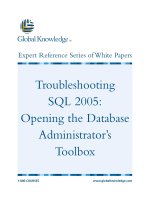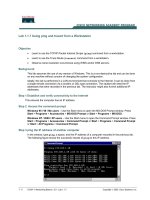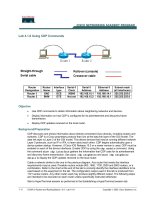Tài liệu Implementing Pessimistic Concurrency Without Using Database Locks pdf
Bạn đang xem bản rút gọn của tài liệu. Xem và tải ngay bản đầy đủ của tài liệu tại đây (36.85 KB, 14 trang )
[ Team LiB ]
Recipe 6.13 Implementing Pessimistic Concurrency Without Using Database Locks
Problem
You need the safety of pessimistic locking without the overhead of database locks.
Solution
Use extra columns and stored procedures as shown in the following examples.
The schema of table TBL0613 used in this solution is shown in Table 6-19
.
Table 6-19. TBL0613 schema
Column name Data type Length Allow nulls?
Id int 4 No
Field1 nvarchar 50 Yes
Field2 nvarchar 50 Yes
LockId uniqueidentifier 16 Yes
LockDateTime datetime 8 Yes
The sample uses seven stored procedures, which are shown in Example 6-31 through
Example 6-37
:
SP0613_AcquireLock
Used to lock a record specified by an Id parameter in the table TBL0613 in the
database. The lock is effected by setting the LockId field of an unlocked record,
where the value of the LockId field is null, to a GUID specified by an input
parameter.
SP0613_ReleaseLock
Used to clear the lock on a record in the table TBL0613 by setting both the LockId
and LockDateTime columns to null. The record is identified by an Id parameter. A
LockId parameter—obtained by executing the SP0613_AcquireLock stored
procedure—must be supplied to clear the lock on a record.
SP0613_Delete
Used to delete a record specified by an Id parameter from the table TBL0613 in
the database. A LockId parameter—obtained by executing the
SP0613_AcquireLock stored procedure—must be supplied to delete the record.
SP0613_Get
Used to retrieve a record specified by an Id parameter or all records from the table
TBL0613 in the database. An expression column, called IsLocked, is also returned
indicating whether the row is currently locked by any user.
SP0613_Insert
Used to insert a new record into the table TBL0613 in the database.
SP0613_Update
Used to update a record in the table TBL0613 in the database. A LockId
parameter—obtained by executing the SP0613_AcquireLock stored procedure—
must be supplied to update the record.
SP0613_PurgeExpired
Used to remove locks older than a specified number of seconds by setting the
LockId and LockDateTime values for those records to null.
Example 6-31. Stored procedure: SP0613_AcquireLock
CREATE PROCEDURE SP0613_AcquireLock
@Id int,
@LockId uniqueidentifier
AS
update TBL0613
set
LockID=@LockID,
LockDateTime=GetDate( )
where
Id=@Id and
LockId IS NULL
return @@rowcount
Example 6-32. Stored procedure: SP0613_ReleaseLock
CREATE PROCEDURE SP0613_ReleaseLock
@Id int,
@LockID uniqueidentifier
AS
update
TBL0613
set
LockId=NULL,
LockDateTime=NULL
where
Id=@Id and
LockID=@LockID
return @@rowcount
Example 6-33. Stored procedure: SP0613_Delete
CREATE PROCEDURE SP0613_Delete
@Id int,
@LockID uniqueidentifier
AS
SET NOCOUNT ON
delete
from
TBL0613
where
Id=@Id and
LockId=@LockId
return @@ROWCOUNT
Example 6-34. Stored procedure: SP0613_Get
CREATE PROCEDURE SP0613_Get
@Id int=null
AS
SET NOCOUNT ON
if @Id is not null
begin
select
Id,
Field1,
Field2,
IsLocked =
case
when LockId is null then 0
else 1
end
from
TBL0613
where
Id=@Id
return 0
end
select
Id,
Field1,
Field2,
IsLocked =
case
when LockId is null then 0
else 1
end
from
TBL0613
return 0
Example 6-35. Stored procedure: SP0613_Insert
CREATE PROCEDURE SP0613_Insert
@Id int,
@Field1 nvarchar(50),
@Field2 nvarchar(50)
AS
SET NOCOUNT ON
insert TBL0613(
Id,
Field1,
Field2)
values (
@Id,
@Field1,
@Field2)
if @@rowcount=0
return 1
return 0
Example 6-36. Stored procedure: SP0613_Update
CREATE PROCEDURE SP0613_Update
@Id int,
@Field1 nvarchar(50)=null,
@Field2 nvarchar(50)=null,
@LockID uniqueidentifier
AS
update
TBL0613
set
Field1=@Field1,
Field2=@Field2
where
Id=@Id and
LockId=@LockId
return @@ROWCOUNT
Example 6-37. Stored procedure: SP0613_PurgeExpired
CREATE PROCEDURE SP0613_PurgeExpired
@timeoutSec int
AS
SET NOCOUNT ON
UPDATE TBL0613
SET
LockId = null,
LockDateTime = null
WHERE









